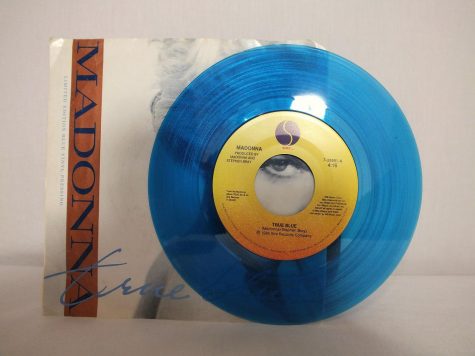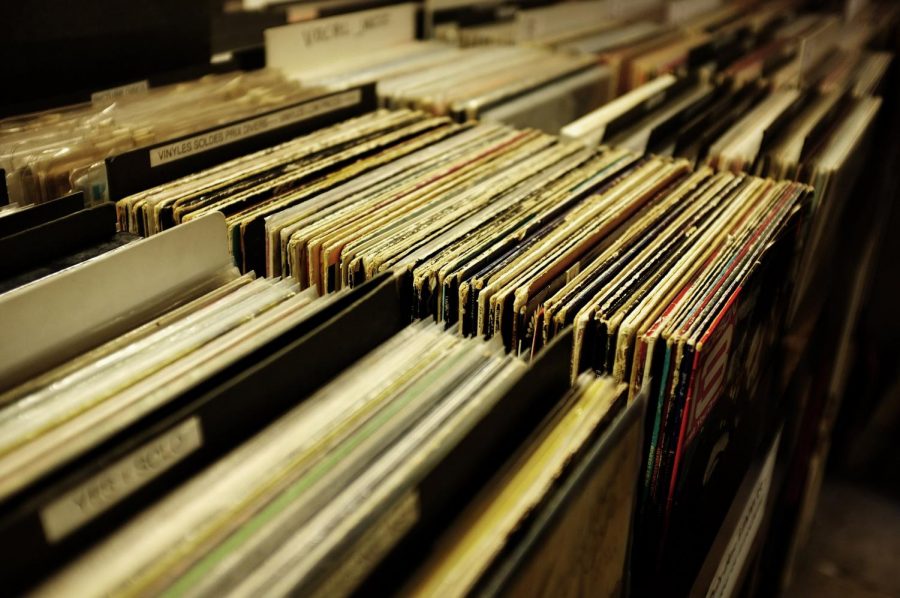The Revival of Vinyl
Despite living in an age of digital streaming, some UMass students have found a love for collecting vinyl
The Puffton apartment just outside of UMass Amherst is inhabited by four college guys who regularly hang out on their beige L-shaped couch. Despite the cluttered apartment’s affinity for modern technology — A 70-inch-TV, Xbox One, PlayStation 4 and stereo speakers — the eye naturally finds the wall decorated with 12 vinyl albums. The Beatles walk across Abbey Road as Whitney Houston sits proudly on her album cover above them, and the iconic alien ships of the Boston album instantly showcase a passion for music. Benjamin Thompson, a junior majoring in finance, discovered his love for vinyl in high school upon finding his father’s collection. He owns 79 records, with one pile in his apartment dedicated to his current listening choices and another for storage. He appreciates the interactive experience of listening to vinyl; physically caring for the albums and record player, looking at album art and liner notes, and flipping albums over are all part of that experience. He recently bought “The Sunny Side of Cher” because he knew the vinyl would inspire him to listen intently to the entire album.
“When I started buying older records, I realized that the form they were made for was vinyl… their intention was [for us] to listen to the album in the order that they put from front to back, A to B,” said Thompson, “I like that you have to sit there and listen to a whole album… instead of just picking out the songs you want.” He mentioned how albums like Abbey Road are meant to be listened to in order since the songs tell a holistic story when played sequentially.
Thompson enjoys “slowing down.” Instead of pushing a button on his record player to automatically play music, he prefers to pick up the needle and move it himself; the crackle of the needle mixed with music reminds him to be more present when listening to albums. Thompson’s interest perfectly represents the niche of collecting vinyl records in modern-day times.

Vinyl records have been making a surprising comeback in the 21st century, capturing the interest of young people looking to expand their musical experience. While vinyl sales are not, and probably won’t ever be, the same as they once were in their golden age, The Recording Industry Association of America has reported slight increases in sales. According to the RIAA’s 2018-Year-End Music Industry Report, vinyl revenues totaled $419 million, the highest level since 1988. The Mid-Year 2019 report, which is the most recent information available, stated $224 million in revenue so far. Even though vinyl only accounts for 4% of total industry revenue, with digital streaming services like Spotify and Apple Music knocking every medium out of the park, tangible music will not let itself die.
Being a vinyl consumer myself, I often frequent the underground store in Northampton, “Turn It Up!” Rows of vinyl, CD and DVD stacks make it hard to maneuver around customers, all hoping to find something special. Guitar solos periodically surround the store as music from the ‘70s mix with the aroma of old album covers. Older customers peruse silently, impervious to everyone. A couple of groups of college-aged kids are on the hunt as well, traveling in packs and sharing their finds.
A line forms at the register. There are two middle-aged men behind the counter, one adding price stickers to a huge stack of CDs while the other rings up the customers. Some areas look like they haven’t been touched in years, with thick cobwebs covering the ground-level windows. The walls and ceiling are covered in pop culture posters of all ages. A “Star Wars: A New Hope” poster catches my eye, and dusty trinkets litter every available space. Nothing is left uncovered. Somehow, it all makes sense. Nothing about this store is forced. The atmosphere somehow manages to entrance everyone, young and old, in with the magic of nostalgia.
UMass Journalism Professor Nicholas McBride, who teaches “American Music as History, Politics and Metaphysics,” recalls a time when vinyl was the only medium available to music consumers. “That was the only thing you could get, so it’s not like ‘back to vinyl,’ I mean this was the norm.” Miles Davis, emanating from his Bose CD player, filled his office with smooth jazz as McBride recounted the good old days. When he was growing up in Springfield MA during the ‘60s, his mother collected vinyl and would bring him to the record store where he witnessed the normal process of curating your own music. His mother knew the record store owner, who would help her find the music she was looking for.
He acknowledged that the aesthetic nature of vinyl translated to every music medium up until the digital age, and he jokingly admitted he thought CDs would be the final stop. McBride said he and his brother own about 5,000 CDs, never imagining digital streaming to be the next step: “I’m just getting to the point where I’m seeing Spotify as convenient, but for me, it will never replace what I get from this (CDs and vinyl) aesthetically.” The album covers and liner notes — which encompasses the work that goes into making music — are part of the tactile experience. Like Thompson, McBride reiterated the process of slowing down and really experiencing the music you consume. Though he prefers CDs, he says vinyl carries the same physical experience. The concrete, interactive practice of building a collection and slowing down to appreciate it truly satisfies our senses.
Ethan Smith, a junior majoring in journalism, is another student who appreciates vinyl and the process of discovering new music. His love for vinyl blossomed in high school as well, especially with hip-hop and its golden age music and DJs like Big Daddy Kane and Public Enemy. Again, the common theme of owning music that is tangible is important to Smith, who says he owns about 60 records. “A lot of artists put their taste and style and other images around the album that help shape [it], like liner notes or other random notes… this makes it meaningful to me and you can’t always get that through the digital experience,” said Smith.
The memories he associates with music is what makes his connection to the albums more meaningful to him; experiences like bonding with his father over his record collection or exploring cool record stores. Smith talked about going to various record stores and exploring old records that haven’t been touched in decades. He spoke in length about shopping in stores like “Turn It Up!” in Northampton, Mass., “Rough Trade” in New York City and “Amoeba Records” in West Hollywood, California.
The wall of vinyl in Thompson’s apartment is a testament to the connection people will always have with music. They were the first decorations put up when he and roommates moved in, much to their amusement. Every once and a while, Thompson will stand on his couch and reach for an album to take down and play, and they always return to their rightful place for everyone to see. Slowing down forces us to form a relationship with our other senses because it’s not just about hearing music, vinyl is an experience.
“I appreciate that when you listen to a record it doesn’t sound perfect. It sounds more real and authentic. And I don’t mean to sound like an ‘old head’, but I think it’s great people are stepping away from their phones and returning to something that’s a little bit more old fashioned.”
Email Faith at [email protected] or follow her on Twitter @faith_doza











